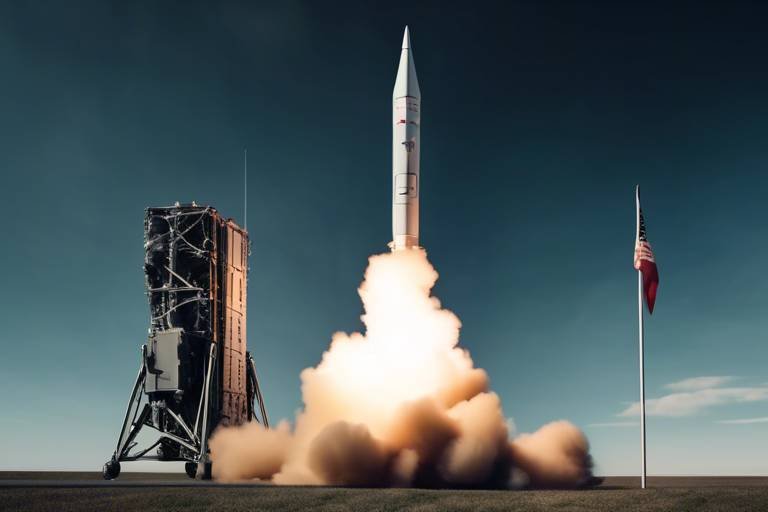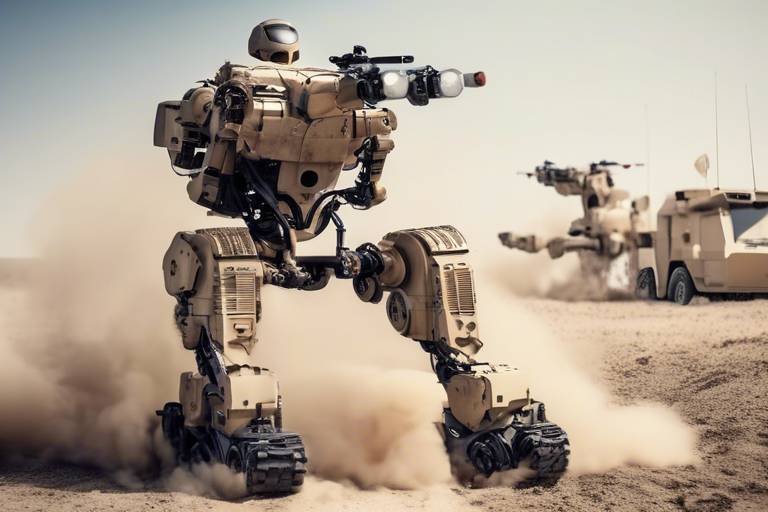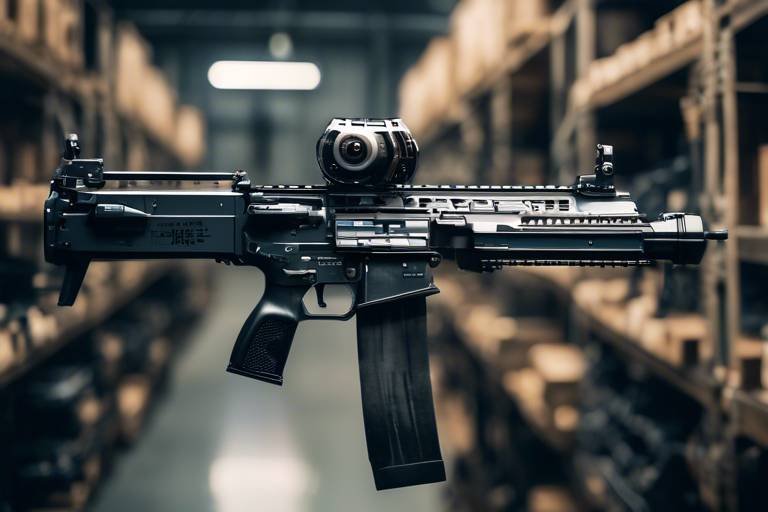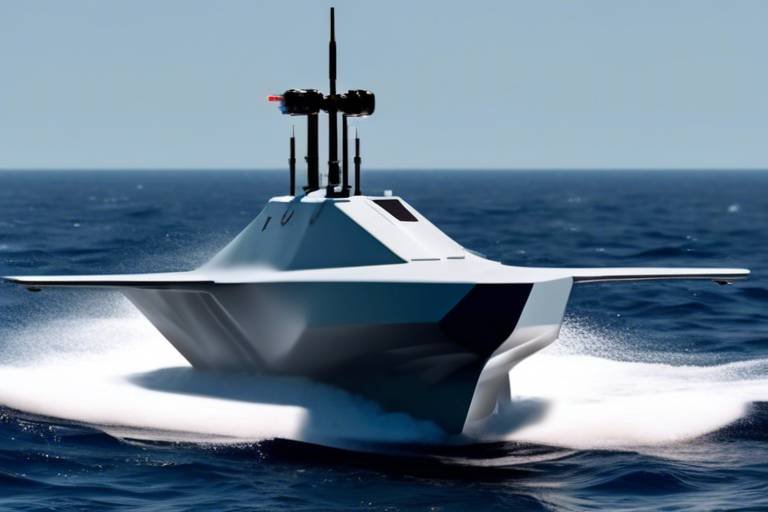Exploring the Potential of AI in Missile Defense Systems
In an era where aerial threats are becoming increasingly sophisticated, the integration of artificial intelligence (AI) into missile defense systems is nothing short of revolutionary. Imagine a world where machines can analyze vast amounts of data in real-time, making split-second decisions that could mean the difference between safety and catastrophe. This article delves into how AI is not just a buzzword but a transformative force in enhancing missile defense capabilities.
Missile defense systems are designed to detect, track, and intercept incoming missiles, thereby protecting nations from potential attacks. Traditionally, these systems relied heavily on human operators and conventional technologies, which, while effective, often lagged in speed and efficiency. However, with the advent of AI, the landscape is changing dramatically. AI technologies are being harnessed to improve the accuracy and responsiveness of these systems, making them more adept at handling complex threats.
One of the most exciting aspects of AI in missile defense is its ability to process and analyze data at unprecedented speeds. For instance, AI algorithms can sift through millions of data points from various sensors and intelligence sources, identifying potential threats faster than any human could. This capability not only enhances the effectiveness of missile defense systems but also significantly reduces the time required to respond to threats, which is crucial in high-stakes situations.
As we explore the potential of AI in missile defense, it's essential to consider both its capabilities and the challenges that come with it. AI can improve decision-making processes, enhance target identification, and optimize overall system performance. However, this integration is not without its hurdles. Issues such as data security, ethical considerations, and the need for rigorous testing are paramount in ensuring that AI systems function as intended without compromising national security.
Looking forward, the future of AI in missile defense systems appears bright. As technology continues to evolve, we can expect even more advanced capabilities that will further enhance the ability of nations to protect themselves against emerging threats. The question remains: how will we navigate the complexities of integrating these powerful technologies while maintaining ethical standards and ensuring the security of sensitive data?
- What is the primary role of AI in missile defense systems? AI enhances the speed and accuracy of detecting and responding to aerial threats, improving overall operational efficiency.
- What challenges does AI face in missile defense? Key challenges include data security, ethical implications of autonomous decision-making, and the need for thorough testing and validation.
- How does AI improve target detection? AI algorithms utilize machine learning techniques to analyze data and identify potential threats more accurately and quickly than traditional methods.
- What are the ethical concerns surrounding AI in military applications? The use of AI in military contexts raises questions about accountability and the implications of machines making life-and-death decisions.

Understanding Missile Defense Systems
Missile defense systems are the backbone of national security, acting as a shield against aerial threats that could potentially devastate cities and endanger lives. These systems are not merely a collection of weapons; they are intricate networks of technology, strategy, and human expertise designed to detect, track, intercept, and neutralize incoming missiles. To truly grasp their significance, we need to explore their various components and operational principles.
At the core of any missile defense system lies a combination of radar systems, interceptors, and command and control centers. The radar systems serve as the eyes of the defense network, constantly scanning the skies for any sign of missile launches. Once a threat is detected, the information is relayed to command centers where sophisticated algorithms and human analysts assess the situation. The next step involves launching interceptors, which are specially designed missiles aimed at neutralizing the threat before it can reach its target.
In today's rapidly evolving technological landscape, the integration of advanced technologies is more crucial than ever. Traditional missile defense systems, while effective, often struggle to keep up with the speed and complexity of modern aerial threats. This is where artificial intelligence (AI) comes into play. By harnessing the power of AI, these systems can analyze vast amounts of data in real time, making quicker and more informed decisions. Imagine a chess game where the AI can predict your opponent's moves before they even make them; that’s the level of foresight AI brings to missile defense.
Moreover, missile defense systems are not standalone entities. They operate within a broader framework of national and international defense strategies. This interconnectedness means that advancements in one area can significantly impact others. For instance, the development of hypersonic missiles poses a new challenge for missile defense systems, necessitating rapid adaptations and innovations in detection and interception technologies.
To illustrate the components of missile defense systems, consider the following table:
| Component | Function |
|---|---|
| Radar Systems | Detect and track incoming missiles |
| Command and Control Centers | Analyze threats and coordinate responses |
| Interceptors | Neutralize incoming threats |
| Communication Systems | Facilitate information sharing between components |
In conclusion, understanding missile defense systems requires a holistic view of their components and operational principles. As we venture further into the age of AI, the potential for these systems to evolve and enhance national security becomes increasingly apparent. The integration of AI not only promises to improve efficiency but also to adapt to the ever-changing landscape of aerial threats. The future of missile defense is not just about intercepting missiles; it's about creating a resilient defense network capable of protecting nations from the uncertainties of modern warfare.
- What are missile defense systems designed to do?
Missile defense systems are designed to detect, track, intercept, and neutralize incoming missiles to protect national security. - How does AI enhance missile defense systems?
AI enhances missile defense systems by improving decision-making, enhancing target identification, and optimizing overall system performance. - What challenges do missile defense systems face?
Challenges include data security, ethical considerations, and the need for robust testing and validation processes. - What is the future of missile defense systems with AI?
The future includes advancements in technology that will enhance capabilities, making systems more effective against emerging threats.

The Role of AI in Defense Technologies
Artificial intelligence (AI) is not just a buzzword; it’s a game-changer in the realm of defense technologies. Imagine having a super-intelligent assistant that can analyze vast amounts of data, make lightning-fast decisions, and enhance the capabilities of missile defense systems. Sounds like something out of a sci-fi movie, right? But it’s happening right now! AI is revolutionizing how we approach national security by improving decision-making processes, enhancing target identification, and optimizing the overall performance of missile defense applications.
One of the most significant contributions of AI in defense technologies is its ability to process and analyze data at unprecedented speeds. Traditional systems often struggle with the sheer volume of information generated during missile detection and tracking. However, AI algorithms can sift through this data, identifying patterns and drawing conclusions much faster than a human operator ever could. This capability not only speeds up the decision-making process but also increases the accuracy of threat assessments. As a result, military personnel can respond to potential threats more effectively, ensuring that they are always one step ahead.
Moreover, AI enhances target identification, which is crucial in missile defense scenarios. With the integration of machine learning techniques, systems can learn from past encounters, improving their ability to distinguish between real threats and false alarms. For instance, AI can analyze flight patterns, speed, and trajectory to determine whether an incoming object is a missile or merely a bird flying by. This level of precision is vital in preventing unnecessary responses that could escalate tensions unnecessarily.
But let’s not forget about the optimization of system performance. AI can continually assess and refine missile defense strategies based on real-time data. This means that as new threats emerge, the systems can adapt and evolve, ensuring that nations are always protected against the latest advancements in missile technology. Think of it like a chess game where the AI is constantly recalibrating its strategy based on the opponent’s moves, ensuring a winning position at all times.
To illustrate the transformative role of AI, consider the following table that highlights key areas where AI is making an impact in defense technologies:
| Area of Impact | Description |
|---|---|
| Decision-Making | AI enhances real-time decision-making by processing data faster than human operators. |
| Target Identification | Improves accuracy in distinguishing between threats and non-threats using machine learning. |
| System Optimization | Continuously adapts defense strategies based on evolving threats and conditions. |
In conclusion, the role of AI in defense technologies is not just about keeping pace with advancements; it’s about setting the pace. As we continue to explore the potential of AI, it’s clear that its integration into missile defense systems will lead to unprecedented levels of security and efficiency. The future of national defense is bright, and AI is at the forefront, ready to tackle the challenges of tomorrow.
- How does AI improve decision-making in missile defense? AI processes data rapidly, allowing for quicker and more accurate threat assessments.
- What are the benefits of enhanced target identification? Improved target identification reduces false alarms and ensures appropriate responses to real threats.
- Can AI adapt to new threats? Yes, AI systems can learn and evolve, optimizing defense strategies based on real-time data.
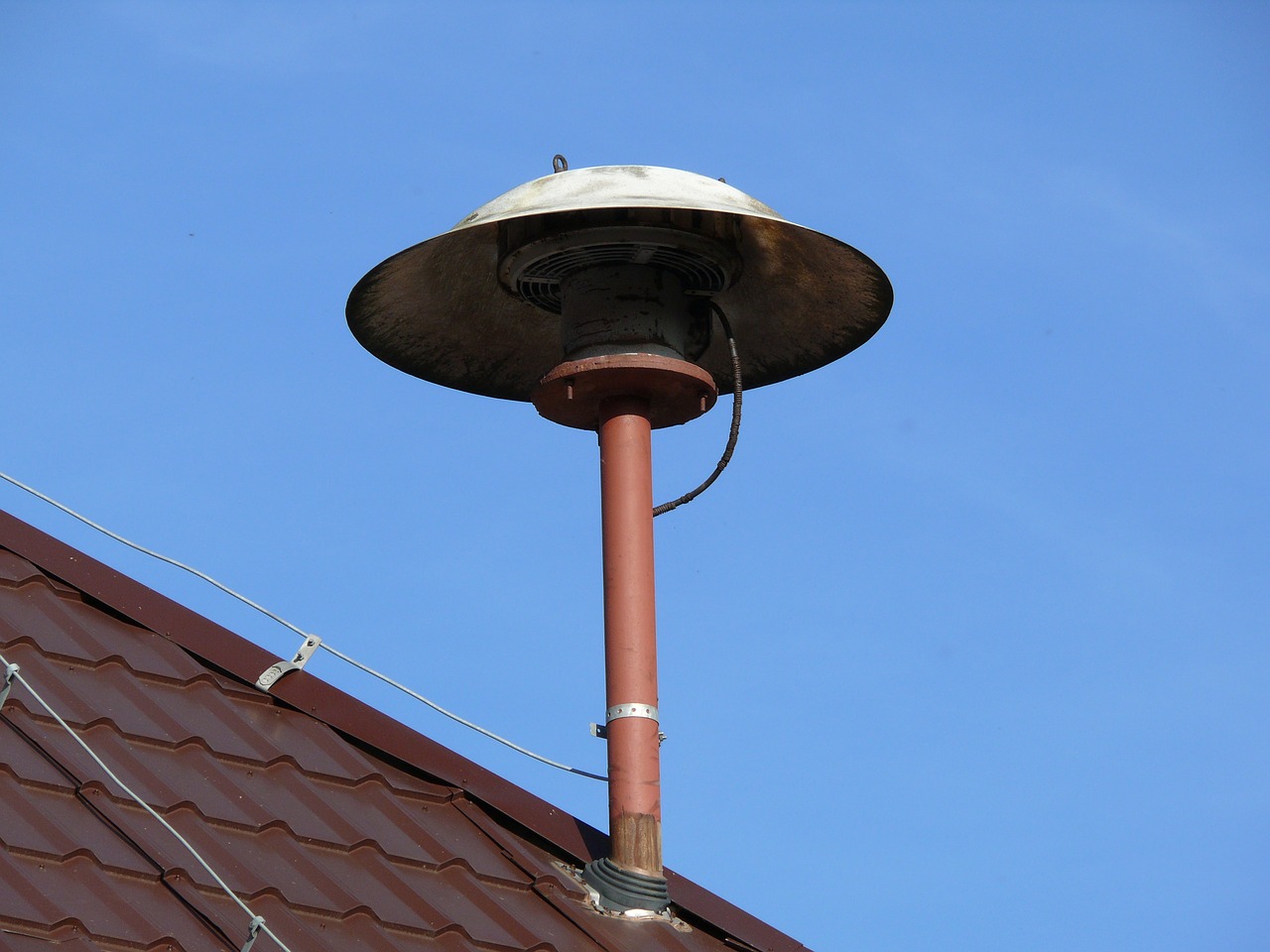
AI-Enhanced Target Detection
In the ever-evolving landscape of missile defense systems, stands out as a game-changer. Imagine a world where machines can sift through mountains of data in the blink of an eye, pinpointing threats that would take human operators much longer to identify. This is not science fiction; it’s the reality brought forth by artificial intelligence. By leveraging machine learning algorithms, missile defense systems can now achieve unprecedented levels of accuracy and speed in detecting potential aerial threats.
One of the most significant advantages of AI in target detection is its ability to process vast amounts of information from various sensors and data sources. Traditional systems often struggle with the overwhelming influx of data, leading to delays in threat identification. In contrast, AI systems can analyze this data in real-time, significantly reducing the time it takes to respond to incoming threats. For instance, a missile defense system equipped with AI could analyze radar signals, satellite imagery, and even social media chatter to assess potential risks. This multi-faceted approach allows for a more comprehensive understanding of the threat landscape.
Furthermore, AI algorithms excel at distinguishing between real threats and false alarms. In missile defense scenarios, the cost of misidentifying a threat can be catastrophic. By utilizing advanced techniques such as neural networks, AI can learn from past incidents and continuously improve its accuracy. These networks mimic the way the human brain processes information, enabling them to recognize patterns and anomalies that may indicate a threat. The result? A more reliable system that enhances national security.
To illustrate the effectiveness of AI in target detection, consider the following table that outlines the differences between traditional detection methods and AI-enhanced systems:
| Aspect | Traditional Methods | AI-Enhanced Methods |
|---|---|---|
| Data Processing Speed | Slower due to manual analysis | Real-time processing |
| Accuracy | Prone to false positives | Higher accuracy with reduced false alarms |
| Adaptability | Limited learning from past data | Continuously learns and improves |
In addition to improving detection capabilities, AI also plays a crucial role in data fusion. When multiple sensors detect an incoming missile, AI can integrate this information to create a clearer picture of the situation. This holistic approach not only enhances situational awareness but also allows for more informed decision-making. As we move forward, the integration of AI in missile defense systems will likely become even more sophisticated, with the potential to revolutionize how nations protect themselves from aerial threats.
- What is AI-enhanced target detection? AI-enhanced target detection refers to the use of artificial intelligence algorithms to improve the speed and accuracy of identifying potential threats in missile defense systems.
- How does AI improve accuracy in missile defense? AI improves accuracy by utilizing machine learning techniques that allow systems to learn from past data and distinguish real threats from false alarms.
- What role does data fusion play in missile defense? Data fusion combines information from multiple sources to create a comprehensive understanding of the threat landscape, enhancing situational awareness.

Machine Learning Techniques
When we talk about in the context of missile defense systems, we're diving into a realm where technology meets critical decision-making. These techniques are not just buzzwords; they are the backbone of how modern defense systems operate. Imagine a vast ocean of data generated from various sensors, radars, and intelligence sources. Machine learning algorithms swim through this data, identifying patterns and anomalies that human operators might miss. This capability is crucial for distinguishing between real threats and false alarms, ensuring that defense systems react appropriately and swiftly.
At the heart of these machine learning techniques are neural networks, which mimic the way human brains process information. They are particularly effective in recognizing complex patterns in data. For instance, when a missile is launched, a neural network can analyze the trajectory, speed, and other parameters almost instantaneously, providing operators with actionable insights. This rapid analysis is vital in missile defense, where every second counts. Moreover, these networks can learn and improve over time, becoming more adept at identifying potential threats as they are exposed to more data.
Another powerful technique is support vector machines (SVM), which are excellent for classification tasks. In missile defense, SVMs can help categorize incoming objects as either friendly or hostile based on their characteristics. This classification process is essential for making quick decisions about whether to engage a target or not. Additionally, decision trees can provide clear, interpretable models that outline the decision-making process, which is crucial for operators who need to understand the rationale behind automated decisions.
Data fusion, a key component in missile defense systems, also benefits from machine learning. By integrating information from multiple sources—like satellite imagery, radar data, and ground sensors—machine learning algorithms can create a comprehensive picture of the battlefield. This fusion of data not only enhances situational awareness but also improves the accuracy of threat detection. For example, if a missile is detected by radar, machine learning can analyze visual data from satellites to confirm the threat, reducing the chances of false positives.
In summary, the integration of machine learning techniques into missile defense systems represents a significant leap forward in our ability to protect nations from aerial threats. As these technologies continue to evolve, they promise to enhance the efficiency and effectiveness of defense operations, ensuring that we stay one step ahead of potential adversaries.
- What is machine learning?
Machine learning is a subset of artificial intelligence that enables systems to learn and improve from experience without being explicitly programmed. It analyzes data to identify patterns and make predictions.
- How do neural networks work?
Neural networks are computational models inspired by the human brain. They consist of layers of interconnected nodes (neurons) that process input data and learn to recognize patterns through training.
- What is data fusion?
Data fusion is the process of integrating data from multiple sources to create a more accurate and comprehensive understanding of a situation, which is crucial in missile defense systems.
- Why is machine learning important in missile defense?
Machine learning enhances the speed and accuracy of threat detection and decision-making in missile defense systems, which is vital for national security.

Data Fusion in Missile Defense
Data fusion is a critical component in modern missile defense systems, acting as the backbone for effective situational awareness. Imagine trying to piece together a complex puzzle with various pieces scattered across different tables; that’s what missile defense systems face daily. They must integrate data from multiple sources to form a coherent picture of the aerial threats looming over a nation. This integration is where artificial intelligence steps in, enhancing the ability to process and analyze vast amounts of information rapidly and accurately.
At its core, data fusion involves merging data from various sensors, radars, and intelligence sources to create a unified operational picture. This process is not just about collecting data; it’s about making sense of it. For instance, consider a scenario where a missile is launched. The system must quickly gather information from ground-based radars, satellite feeds, and even intelligence reports. AI algorithms play a vital role in filtering out noise and irrelevant data, focusing on what truly matters. By applying machine learning techniques, these systems can learn from previous engagements and improve their accuracy over time.
One of the most significant advantages of data fusion in missile defense is the ability to enhance decision-making. When multiple data streams are integrated, operators can gain insights that would be impossible to achieve with isolated data sources. This holistic view allows for quicker responses to threats, potentially saving lives and resources. In fact, studies have shown that systems employing advanced data fusion techniques can reduce response times by up to 50%, a game-changer in high-stakes scenarios.
However, the implementation of data fusion is not without its challenges. The sheer volume of data generated can overwhelm traditional systems. To combat this, modern missile defense systems utilize sophisticated algorithms that can prioritize and categorize incoming information. This process ensures that operators are not inundated with data but instead receive actionable intelligence. The effectiveness of these systems relies heavily on the quality of the input data. Therefore, combining high-quality sensors with advanced AI-driven data processing is crucial for optimal performance.
Moreover, data fusion also promotes collaboration among various defense entities. By sharing information across different branches of the military and allied nations, a more comprehensive defense strategy can be developed. For example, if one country detects a missile launch, sharing that data with allies can lead to a coordinated response, significantly enhancing collective security. This collaborative approach fosters trust and strengthens international defense partnerships, which is increasingly important in today’s interconnected world.
In summary, data fusion is an indispensable aspect of missile defense systems, enabling them to operate more efficiently and effectively in a rapidly evolving threat landscape. As technology continues to advance, the integration of AI will only enhance these capabilities further, paving the way for smarter, more responsive defense mechanisms. The future of missile defense will undoubtedly rely on the sophisticated interplay of data fusion, machine learning, and collaborative defense efforts to safeguard nations from emerging aerial threats.
- What is data fusion in missile defense?
Data fusion refers to the process of integrating information from various sources to create a comprehensive operational picture, enhancing situational awareness and decision-making in missile defense systems.
- How does AI improve data fusion?
AI enhances data fusion by rapidly processing vast amounts of information, filtering out noise, and providing actionable insights that improve response times and operational efficiency.
- What are the challenges of implementing data fusion?
The main challenges include managing the overwhelming volume of data, ensuring the quality of input data, and integrating information from diverse sources while maintaining system security.
- Why is collaboration important in missile defense?
Collaboration allows different defense entities and allied nations to share critical information, leading to a coordinated response to threats and strengthening collective security.

Autonomous Decision-Making Systems
In the rapidly evolving landscape of missile defense, are becoming a game-changer. Imagine a scenario where a missile is launched, and within seconds, a sophisticated AI system analyzes the threat, evaluates multiple defense options, and executes a countermeasure—all without human intervention. This is not science fiction; it's the future of military defense. The integration of AI in these systems can drastically reduce response times, allowing for swift action against aerial threats that could otherwise cause catastrophic damage.
But how does this work in practice? At the core of autonomous decision-making systems are complex algorithms that process vast amounts of data in real-time. These systems utilize inputs from various sensors, satellites, and intelligence reports to create a comprehensive picture of the battlefield. The ability to synthesize this information quickly is crucial; a delay of even a few seconds can mean the difference between interception and disaster. With AI, these systems can assess the situation, prioritize threats, and determine the best course of action.
However, the implementation of autonomous systems is not without its challenges. One major concern is the ethical implications of allowing machines to make life-and-death decisions. Should a computer be trusted to decide whether to engage a target? This question has sparked intense debates among military leaders, ethicists, and the general public. The fear is that an autonomous system might misinterpret a situation, leading to unintended consequences. For instance, a false positive could result in an unnecessary strike, escalating tensions and potentially igniting conflicts.
Moreover, the operational efficiency of these systems relies heavily on the quality and reliability of the data they process. Inaccurate or incomplete data can lead to poor decision-making, which is why robust testing and validation processes are essential before deploying autonomous decision-making systems in real-world scenarios. This involves extensive simulations and field tests to ensure that the AI can handle a variety of situations and respond appropriately.
As we look to the future, the potential for AI-driven autonomous systems in missile defense is immense. They promise not only to enhance operational capabilities but also to redefine how nations approach defense strategies. However, it is crucial to navigate the accompanying challenges thoughtfully, ensuring that these systems are developed with a strong ethical framework and rigorous security measures in place.
- What are autonomous decision-making systems?
These are AI-driven systems capable of making decisions without human intervention, particularly in high-stakes environments like missile defense.
- How do these systems improve response times?
By processing data rapidly and efficiently, autonomous systems can analyze threats and execute defensive measures much faster than human operators.
- What are the ethical concerns surrounding their use?
The primary concern is whether machines should be entrusted with life-and-death decisions, as errors could lead to catastrophic consequences.
- How important is data quality for these systems?
Data quality is critical; inaccurate information can lead to poor decision-making, underscoring the need for rigorous testing and validation.

Challenges in Implementing AI
Despite the vast potential of artificial intelligence (AI) in missile defense systems, the journey towards successful integration is fraught with challenges. These hurdles can often feel like trying to navigate a minefield—one wrong step, and the consequences could be catastrophic. The complexities involved in deploying AI technology in such critical systems require careful consideration of numerous factors.
One of the foremost challenges is data security. With AI systems relying heavily on vast amounts of data, ensuring that this information is protected from cyber threats is paramount. Imagine a scenario where an adversary gains access to sensitive data; the implications could be dire. Not only could they manipulate the information, but they could also exploit vulnerabilities in the system, leading to catastrophic failures in missile defense. Therefore, robust cybersecurity measures must be implemented to safeguard these data streams.
In addition to data security, there are significant ethical considerations that cannot be ignored. The deployment of AI in military applications raises profound moral questions. For instance, the prospect of autonomous systems making life-and-death decisions creates a dilemma: who is responsible when an AI system miscalculates and leads to unintended consequences? This ethical quagmire demands rigorous debate and the establishment of clear guidelines to govern the use of AI in defense contexts.
Moreover, the need for robust testing and validation processes cannot be overstated. Integrating AI into missile defense systems requires extensive trials to ensure that the technology performs as intended under various scenarios. The stakes are incredibly high; a failure in the field could mean the difference between life and death. Therefore, testing must be thorough and continuous, incorporating real-world conditions to simulate potential threats accurately.
Additionally, the complexity of AI algorithms poses another challenge. While AI can process vast amounts of data and make decisions at lightning speed, understanding the rationale behind these decisions can be difficult. This "black box" nature of AI can lead to mistrust among military personnel who may be hesitant to rely on a system whose decision-making process they do not fully comprehend. Transparency in AI operations is essential to build confidence and ensure that human operators can intervene when necessary.
Lastly, there is the challenge of integration with existing systems. Many missile defense systems have been in place for years, and retrofitting them with AI capabilities can be a daunting task. It requires not only technological upgrades but also comprehensive training for personnel to effectively utilize new tools. A seamless integration process is crucial to avoid operational disruptions that could leave nations vulnerable to aerial threats.
- What are the primary challenges of integrating AI into missile defense systems? The main challenges include data security, ethical considerations, the need for robust testing, algorithm complexity, and integration with existing systems.
- How does data security affect missile defense? Data security is critical because vulnerabilities can lead to unauthorized access and manipulation of sensitive information, jeopardizing national security.
- What ethical concerns arise from the use of AI in military applications? Ethical concerns include accountability for decisions made by autonomous systems, especially in life-and-death situations.
- Why is testing and validation important for AI in missile defense? Thorough testing ensures that AI systems perform reliably under various scenarios, which is essential for maintaining operational readiness and effectiveness.
- How can the complexity of AI algorithms impact military operations? The complexity can create distrust among personnel, as understanding AI decision-making processes may be challenging, potentially hindering effective collaboration.

Ethical Considerations
The integration of artificial intelligence into missile defense systems raises a myriad of that cannot be overlooked. As we stand on the precipice of a new era in military technology, the implications of allowing machines to make critical decisions about life and death become increasingly significant. Imagine a scenario where an AI system autonomously identifies a potential threat and decides to launch a countermeasure without human intervention. This situation leads us to ponder: who is accountable for the consequences of such actions?
One of the most pressing concerns is the notion of autonomy in lethal decision-making. When a machine is programmed to respond to threats, the question arises: can we trust it to make the right call? Unlike human operators, who can exercise judgment based on context and emotion, AI systems operate on algorithms and data patterns. This reliance on data can lead to unintended consequences, especially if the AI misinterprets a situation due to a lack of nuanced understanding. As we delve deeper into the ethical implications, several key issues emerge:
- Accountability: If an AI system makes a fatal error, who is held responsible? Is it the programmer, the military, or the machine itself?
- Bias: AI systems are only as good as the data they are trained on. If the training data is biased, the AI may make flawed decisions that could disproportionately affect certain populations.
- Transparency: The decision-making process of AI systems can be opaque, making it difficult to understand how decisions are reached. This lack of transparency can erode trust in military operations.
Moreover, the ethical implications extend beyond the battlefield. The potential for AI to be used in aggressive military strategies raises questions about global stability and the arms race. Nations might feel pressured to develop their own AI-driven defense systems, leading to an escalation in military capabilities and a shift in the balance of power. The moral responsibility of employing AI in defense is a topic that demands serious deliberation among policymakers, ethicists, and technologists alike.
As we navigate this complex landscape, it is essential to establish frameworks and guidelines that govern the use of AI in military applications. These guidelines should address the ethical implications of autonomous systems, ensuring that human oversight remains a critical component of decision-making processes. By fostering a collaborative dialogue among stakeholders, we can work towards a future where AI enhances missile defense capabilities without compromising our ethical standards.
- What are the main ethical concerns regarding AI in missile defense?
Key concerns include accountability for decisions made by AI, potential biases in AI algorithms, and the transparency of the decision-making process.
- How can we ensure ethical use of AI in military applications?
Establishing clear guidelines and frameworks for the use of AI, alongside maintaining human oversight in decision-making, is crucial for ethical implementation.
- What role do policymakers play in AI ethics?
Policymakers are essential in creating regulations and standards that govern the use of AI in defense, ensuring that ethical considerations are prioritized.

Data Security and Privacy
In the realm of missile defense systems, where the stakes are incredibly high, are not just important—they are paramount. As we integrate artificial intelligence into these systems, we open up a Pandora's box of potential vulnerabilities. Imagine a scenario where sensitive military data is compromised; the implications could be catastrophic, not just for the nation involved but for global security as a whole.
AI systems rely on vast amounts of data to function effectively. This data can include everything from satellite imagery to real-time surveillance feeds. However, the more data we collect, the greater the risk of it falling into the wrong hands. Cyber attacks are a persistent threat, and missile defense systems must be fortified against these intrusions. For instance, consider the following potential vulnerabilities:
- Unauthorized Access: Hackers could gain access to sensitive information, potentially altering defense protocols.
- Data Manipulation: If an adversary can manipulate data inputs, they could mislead AI systems, resulting in catastrophic failures.
- Privacy Breaches: The collection of data must also respect the privacy of individuals, especially when surveillance technologies are involved.
To combat these vulnerabilities, a multi-layered approach to security is essential. This includes implementing advanced encryption techniques, continuous monitoring of AI systems, and regular security audits. Furthermore, organizations must prioritize employee training to ensure that everyone involved understands the importance of data security and the potential risks associated with AI technologies.
Beyond technical measures, ethical considerations also play a critical role in data security. As AI systems become more autonomous, the question arises: who is responsible when a system fails due to data manipulation? Establishing clear accountability is vital to maintain trust in these technologies. Additionally, the ethical implications of surveillance and data collection must be addressed to ensure that privacy is not sacrificed on the altar of national security.
In conclusion, while AI has the potential to revolutionize missile defense systems, we must tread carefully. The integration of these technologies requires a robust framework for data security and privacy. Only by addressing these challenges can we harness the full potential of AI while safeguarding our nations from both external threats and internal vulnerabilities.
- What are the main threats to data security in missile defense systems? The main threats include unauthorized access, data manipulation, and privacy breaches, which can compromise the integrity of defense operations.
- How can organizations protect sensitive data in AI-driven missile defense? Organizations can implement advanced encryption, continuous monitoring, and regular security audits to safeguard sensitive data.
- What ethical considerations arise from using AI in military applications? Ethical considerations include accountability for autonomous decisions, the implications of surveillance, and the need to respect individual privacy rights.

The Future of AI in Missile Defense
The future of artificial intelligence (AI) in missile defense systems is not just a fascinating topic; it's a critical area of development that could reshape the landscape of national security. As we look ahead, we can expect AI to play an increasingly vital role in enhancing the effectiveness and efficiency of missile defense systems. Imagine a world where threats are identified and neutralized almost instantaneously, thanks to the power of AI. This isn't science fiction; it's the direction in which technology is heading.
One of the most exciting prospects is the integration of predictive analytics within missile defense systems. By leveraging vast amounts of historical data, AI algorithms can identify patterns and predict potential threats before they even materialize. This proactive approach allows defense systems to be a step ahead, effectively turning the tables on adversaries. With AI, we are not just reacting to threats; we are anticipating them.
Moreover, the concept of swarm technology is gaining traction. Picture multiple drones or defense units working together in a coordinated manner to intercept a missile threat. AI can facilitate communication and decision-making among these units, ensuring that they operate as a cohesive unit rather than isolated entities. This kind of collaboration could significantly enhance the interception rates of incoming threats, making missile defense systems more formidable than ever.
Furthermore, as AI technology evolves, we can expect improvements in autonomous learning. Future missile defense systems will likely be equipped with AI that can learn from new data in real-time. This means that as threats become more sophisticated, the systems can adapt and evolve their strategies accordingly. For instance, if a new type of missile is identified, the AI can analyze its trajectory and speed, adjusting the defense response on the fly. This adaptability is crucial in a world where threats are constantly changing.
However, with these advancements come challenges that need to be addressed. The integration of AI in missile defense systems raises questions about accountability and control. Who is responsible if an AI system makes a mistake? These are not just theoretical questions; they have real-world implications that must be carefully considered as we move forward. Ensuring that there are robust oversight mechanisms in place will be essential to maintain public trust and ensure ethical standards in military applications.
In conclusion, the future of AI in missile defense systems is bright and full of potential. With advancements in predictive analytics, swarm technology, and autonomous learning, we are on the brink of a new era in national security. Yet, as we embrace these innovations, we must remain vigilant about the ethical implications and security challenges that accompany them. The journey ahead is as exciting as it is complex, and navigating it will require collaboration among technologists, military leaders, and ethicists alike.
- What is the role of AI in missile defense systems?
AI enhances decision-making, improves target identification, and optimizes system performance, making missile defense more effective. - How does predictive analytics improve missile defense?
Predictive analytics allows systems to anticipate threats by analyzing historical data and identifying patterns. - What challenges does AI face in missile defense?
Challenges include ethical considerations, accountability for AI decisions, and ensuring data security and privacy. - What is swarm technology in missile defense?
Swarm technology involves multiple units working together, coordinated by AI, to intercept threats more effectively.
Frequently Asked Questions
- What are missile defense systems?
Missile defense systems are specialized technologies designed to detect, track, and intercept incoming missiles. They play a critical role in national security by protecting a country from aerial threats, including ballistic missiles and other forms of attacks.
- How does AI enhance missile defense systems?
AI enhances missile defense systems by improving decision-making processes, accelerating target identification, and optimizing system performance. With machine learning algorithms, these systems can analyze vast amounts of data quickly, enabling them to distinguish real threats from false alarms more effectively.
- What are the benefits of AI in target detection?
The benefits of AI in target detection include faster response times, increased accuracy in identifying potential threats, and improved situational awareness. AI algorithms can process information from various sources, leading to a more comprehensive understanding of the battlefield.
- What challenges does AI face in missile defense?
Despite its advantages, AI integration into missile defense systems faces several challenges, including data security risks, ethical dilemmas regarding autonomous decision-making, and the need for rigorous testing and validation to ensure reliability and effectiveness.
- Are there ethical concerns related to AI in missile defense?
Yes, there are significant ethical concerns regarding the use of AI in missile defense, particularly when it comes to autonomous systems making life-and-death decisions. The implications of such technology necessitate careful consideration and debate among policymakers and military leaders.
- How can data security be ensured in AI systems?
Ensuring data security in AI systems involves implementing robust cybersecurity measures, including encryption, access controls, and continuous monitoring for vulnerabilities. Protecting sensitive information is crucial to maintaining the integrity of missile defense operations.
- What does the future hold for AI in missile defense?
The future of AI in missile defense looks promising, with advancements expected to enhance capabilities significantly. As technology evolves, we can anticipate improved system efficiencies, better threat detection, and overall stronger national defense mechanisms.

